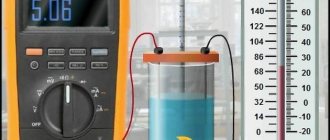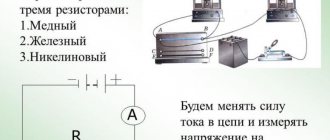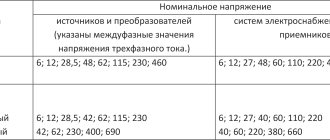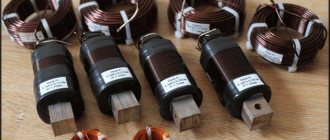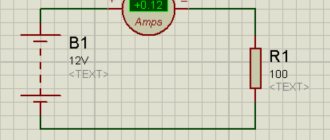The design and operation of electrical devices and installations largely depend on the resistance of materials. The article will describe in detail what the value of electrical resistance of 1 Ohm is.
Additionally, a description of the designation of this unit and the rules for measuring resistance using a multimeter will be given.
Definition
In order to find out what the value of 1 ohm is, you need to know the definition of electrical resistance. Electrical resistance is a physical quantity that determines the resistance of a conductor to the passage of electric current.
Resistance is measured in Ohms. 1 Ohm is the resistance of a section of an electrical circuit between the ends of which an electric current of one ampere flows, and the voltage at its ends is equal to one volt.
This value is indicated in Ohms.
Ohm
All existing materials have the physical ability to conduct electric current. These materials are divided into 2 main groups:
- Insulators. Such materials do not conduct electricity. The most well-known insulators include rubber, wood, glass, and plastic.
- Conductors. These materials have a relatively low resistance, so they freely pass charged electrons through them. In electrical engineering, copper, aluminum, iron, and gold are used.
Ohm is the SI unit of measurement of electrical resistance. This ability of materials was discovered by the German physicist Georg Simon Ohm. The conductivity parameter received its own special designation - the Ohm symbol or the Omega symbol “Ω”.
Physics uses 1 ohm as the base resistance value. A power of 1000 ohms is abbreviated as 1 kohm. Depending on the type of conductor, the resistance can have different values. In physics, the maximum value of resistance is 1 Yottaohm (IOm), which is equal to 10 to the 24th power of Ohm. How many different derivative units of resistance there are can be seen in the figure below.
Due to frequent spelling errors, another designation, Om, was adopted for the European classification system. In many technical manuals you may see the designation "ohm".
Important! In the handwritten version, the word “Ohm” itself is used to denote resistance, and not the Greek letter “Omega”. The “Ω” sign is used in electronic technical manuals and when designating the parameters of radio components.
The conductivity parameter is measured not only according to the SI system. There is the SGS system, which determines conductivity based on the parameters of length, weight and time. GHS parameter or centimeter, gram, second. According to this classification, the electrical conductivity for SGS is designated SGSR. The value indicates the resistance not of the entire conductor, but only of its individual section, taking into account length and weight. The time it takes for a 1-volt charge to travel through this area is also taken into account.
GHS and ordinary electrical conductivity are very different. So one unit of SGSR is equal to 9 * 10 to the 11th power of Ohm. This system has no practical application in radio electronics, due to the fact that many calculated quantities are immeasurable. It is used in calculations of electromagnetism in the Gaussian system, as well as in electrodynamics.
The mystery of numbers
Let's imagine that you have decided to purchase a new model of headphones. Let’s put the budget question aside, since the thickness of each buyer’s wallet is different. Let's immediately pay attention to the characteristics.
An attentive buyer probably paid attention to a number of incomprehensible physical characteristics marked on the beautiful box. Below is a photo with cutouts of three different models of headphones from famous brands:
What to look for when purchasing? So, we have three models with different characteristics:
Model A characteristics:
Frequency Response – Frequency range: 10 Hz – 20 kHz; Impedance – Resistance: 22 OHM; SPL – Volume level: 111 dB (+/- 3 dB);
Model B Specifications:
Frequency Response – Frequency range: 5 Hz – 40 kHz; Impedance - Resistance: 32 OHM; SPL – Volume level: 102 dB (+/- 3 dB);
Model C specifications:
Frequency Response – Frequency range: 5 Hz – 35 kHz; Impedance – Resistance: 250 OHM; SPL – Volume level: 96 dB (+/- 3 dB);
Frequency range. All three models have completely different numerical characteristics. Our task is to determine which headphones will feel more comfortable with a portable player or smartphone. Model B the widest range of reproduced frequencies : from 5 Hz to 40 kHz (even though the human ear perceives a range of only 16 to 20,000 Hz). Thus, the frequency range of all three models will suit anyone, even the most demanding listener. When choosing mid-price headphones, this parameter is not decisive, but is rather of a marketing nature.
Resistance . This is where we get to the most interesting part: all three models are radically different from each other. Let's figure out what the impedance and what is the optimal resistance value for use in conjunction with a smartphone?
All headphones are divided into two categories: low-impedance and high-impedance , and the gradation of this division directly depends on their type. Thus, full-size headphones with an impedance of up to 100 Ohms are considered low-impedance ; above 100 Ohm - high-resistance . In-ear headphones (“plugs” or earbuds) with a resistance value of up to 32 Ohms - low- ; above 32 ohm - high-resistance .
In the acoustic world of full-size speakers and loudspeakers, everything is simple: there is a 30-watt speaker with an impedance of 8 ohms. We connect the corresponding 8-ohm amplifier to the left and right channels and enjoy the loud sound. The situation with headphones is much more complicated and confusing. In the example above alone, we encountered three resistances:
- model A – 22 Ohm;
- model B – 32 Ohm;
- model C – 250 Ohm.
When asked: which headphones are best suited to a smartphone, the average buyer will confidently answer that the best model is the one with minimal resistance. “Low-impedance headphones, when paired with a smartphone, will sound louder, but high-impedance headphones require a separate powerful amplifier,” is a generally accepted statement from a sales assistant at an average electronics store. “Sit down, it’s still a bad grade,” my high school physics teacher would say, and here’s why.
The moment you increase the volume of music playback, the output signal changes not the power level, but the voltage . And only voltage directly affects power. To do this, from a school physics course, it is enough to remember two simple formulas of Ohm’s law:
Thus, to determine which headphones will play LOUDER, and which volumes will not be enough when using only a smartphone, you should pay attention not only to the resistance indicator of the headphones themselves, but also to the maximum voltage level that the minijack port of your smartphone or player. Almost all electronics manufacturers are in no hurry to introduce us to this indicator. As a rule, you can find out the exact voltage at the minijack output only from the device diagrams, which are not easy to find.
You should compare two different models in terms of volume not by power level, but by voltage consumption . The sensitivity of headphones with lower impedance is greater than that of a high-impedance model. But how does this affect the battery life of the smartphone?
Calculation formula
Electrical resistance is calculated using a special formula. It consists of the following values:
- “I” is the current strength acting on the conductor in amperes;
- “U” is the magnitude of electrical voltage in volts;
- “R” is the value of the electrical resistance of the conductor in ohms.
The formula is as follows: I=U/R.
Knowing the operating voltage and current, you can easily calculate the operating resistance. For example, an electric furnace operates at 240 volts at 2 amps.
240/2=120 Ohm.
Operating resistance is a determining parameter in the operation of electrical equipment and its repair.
As the resistance increases, the conductivity and, therefore, the current in the circuit decreases significantly. As the resistance decreases, the current increases greatly.
These features of conductors are often used by engineers. For example, to obtain a high temperature, a spiral with high resistance is used. Conversely, a very low resistance tungsten filament is used to light an incandescent lamp.
As you know, any physical impact entails the release of thermal energy. Using the conductivity value, you can easily calculate the amount of heat generated or Watts. This is done using the formula: W=A×Ohm.
How to measure headphone impedance?
To obtain a detailed schedule, you need specialized software and a stand. But to find out the value of active resistance (in the region of the lowest frequencies), a budget multimeter, costing from 200 rubles, is enough.
It is quite normal when buying headphones to check the impedance of the right and left channels; the discrepancy should not exceed 2-3 ohms between channels in most cases.
Author Kuznetsov Roman romanrex
Metering
The most famous radio component with a stable operating resistance is a resistor. This element has no inductance or capacitance, so it can reduce the output resistance without loss for stable operation of other circuit components.
In order to check the resistance of the conductor, an ohmmeter is used. You can also measure with an electronic multimeter equipped with an ohmmeter function.
Next, the measurement process will be described using an ordinary resistor as an example.
- Set the multimeter to ohmmeter mode. The device has its own designation for the ohm icon - this is the symbol “Ω”.
- Connect the red test lead to the resistor contact.
- Connect the black measuring probe to the second contact of the element.
- The ohms obtained on the device display must be compared with the markings on the body of the part.
Resistors receive a special designation on the case, equal to the ability of the radio component to conduct electric current. When measuring, the values should not deviate greatly from the reference values.
Important! This parameter can only be measured on a de-energized circuit. Before measuring the circuit, it is worth checking the voltage on the capacitors and discharging them.
The resistance parameter can also be used to check the integrity of the elements of an electrical circuit. To accurately determine the cause of a malfunction in electrical appliances, the technician must know the operating resistance of the device or the current at which it operates. If the operating parameter increases during the measurement process, we can conclude that there is a short circuit in the circuit, burnt contacts or damage to the inductor. With a significant decrease in the parameter, the current value will increase, which will cause burnout of capacitors, some resistors, and an increase in the overall operating temperature of the device.
Modern multimeters have a “ringing” function with a sound alert. This mode can be easily replaced by the ohmmeter mode. Using an ohmmeter, you can measure the integrity of wiring strands and determine the integrity of the windings of electric motors and inductors.
Very often, beginners use the parameter of electrical conductivity and operating voltage to calculate the current strength for the normal functioning of the device. Such calculations can only be made during design, using the formula: A=B/Ohm. Having an already functional device, the calculation may be incorrect if the operating resistance was overestimated/underestimated by failed circuit elements.
